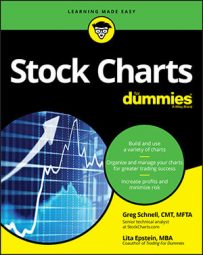Identifying the key attributes for your stock chart style
Personalizing your stock charts to make it easier for you to read them can improve your ability to track your portfolio and pick stocks. Here are some key attributes you want to consider:
- Chart type: You must choose the type of chart you want, such as candlestick, bar, line, or area.
- Period: You must choose a period for your chart. The period you choose depends on the decision you want to make. Periods include monthly, weekly, daily, hourly, or by a set number of minutes.
- Range: You must choose the range for your chart, which can be as little as one day or as long as ten years.
- Color scheme: You can choose a color scheme for your chart. One common difference is to set one color for up days and a different color for down days. You can choose the colors that make it easier for you to read and use the charts.
- Grids: These are the lines you see on the screen. You can set each line’s appearance as solid, dashed, or dense.
- Legends: This is where you find the detail about the stocks or other assets for which you are developing a chart. You can decide how much detail you want to show.
Adding key overlays to stock charts for decision making
Many types of overlays are available to help you read your stock charts. Here are some of the basic overlays you can add to your stock charts:
- Moving averages: Help you more easily spot a trend by smoothing out price action based on past prices
- Horizontal line: Enables you to more easily see the top and bottom of a trend
- Price channels: Help you see the highest high and the lowest low on a chart
- Bollinger Bands: Show the upper and lower limits of normal price movements
- Keltner channels: Show the upper and lower limits for price movements based on an average of prices
- Moving average envelopes: Form a channel using simple moving averages
- Events: Mark important events such as dividends and stock splits
- Pivot points: Show the point at which the largest price movement is expected (used primarily by short-term traders)
Selecting indicators of price movement and volume on a stock chart
Indicators of price movement and volume on a stock can be a helpful tool to enhance your stock chart style. Here are the key indicators to focus on:
- Relative strength indicator (RSI): Shows how strongly a stock is moving in its current direction, whether up or down
- Chaikin money flow (CMF): Combines price and volume to show the movement of money in and out of a stock
- On-balance volume (OBV): Combines price and volume to show how money is moving in and out of a stock
- Percent price oscillator (PPO): The percentage-based version of the moving average convergence divergence indicator (MACD)
- Percent volume oscillator (PVO): The PPO indicator applied to volume rather than price
- Force index: Shows the movement of price and volume
- Price momentum oscillator (PMO): Tracks the stock’s rate of change
- Stochastics: Show speed of stock price relative to past movements
- StockCharts technical ranking (SCTR): Ranking based on a stock’s technical strength
How to use your stock charts and technical analysis in trading
As you develop and perfect your stock charting styles, you need to make use of the information you find in the charts to help you focus on what is happening in the market. For example, charts can help you
- Determine economic cycle position.
- Determine position within sector rotation.
- Decide which sectors are ascending.
- Determine leading stocks in the ascending sector.
- Confirm economic cycle with index charts.
- Determine whether leading sectors are range bound or trending.
- Determine whether leading stocks are range bound or trending.
How to improve your stock picking results with journaling
Picking the right stocks is the goal of every stock chart user. You can improve your stock picking results by tracking these key items in a journal:
- Keep track of your winners and losers.
- Analyze each trade to track what you did wrong and what you did right. You can use the information to repeat your successes. You can also use the information to hopefully avoid making the same error in the future.
- Keep buying winners. After you discover a strategy for finding and buying winners, keep notes and continue to improve on your decision-making strategies.
- Stop holding losers. Analyze a losing trade and get out before it becomes an even bigger loser.
- Keep more of your winners. With charting and a good understanding of trends, you can feel more confident about when to hold and when to sell your winners.

